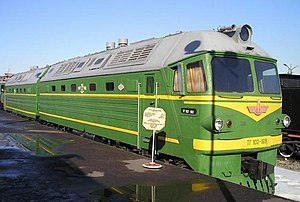SŽD series ТГ102
| SŽD series ТГ102 | |
|---|---|
|
ТГ102.169
|
|
| Numbering: | different numbering according to equipment and manufacturer |
| Number: | 79 |
| Manufacturer: |
Luhansk Leningrad locomotive factory Lyudinovo diesel locomotive factory |
| Year of construction (s): | 1959-1966 |
| Axis formula : | B'B '+ B'B' |
| Gauge : | 1520 mm |
| Length over coupling: | Single locomotive: 14,720 mm |
| Bogie axle base: | 2,500 mm |
| Total wheelbase: | Single locomotive: 9,400 mm |
| Service mass: | Single locomotive: 83 t |
| Friction mass: | Single locomotive: 83 t |
| Wheel set mass : | 20.5 t |
| Top speed: | 120 km / h |
| Installed capacity: | 4 × 1,000 hp |
| Starting tractive effort: | Single locomotive: N 24,000 |
| Wheel diameter: | 1,050 mm |
| Motor type: | 12-cylinder four-stroke diesel engine |
| Motor type: | M 756 |
| Rated speed: | 1,500 min -1 |
| Power transmission: | hydraulic |
| Tank capacity: | Single locomotive: 5,900 l |
The locomotives of the SŽD series ТГ102 (German transcription TG 102) of the Soviet Railways (SŽD) are wide-gauge diesel locomotives with diesel-hydraulic power transmission primarily for mixed service.
history
The locomotive was created in 1959 from the experience with the prototype locomotive SŽD series ТГ100 , which was created in 1959 by the Luhansk Locomotive Factory . As a result of testing this machine, the 4,000 hp two-section locomotive of the TG 102 series was created . The Luhansk locomotive factory also produced them with hydrodynamic power transmission as a prototype with the designation ТГ102.001 . The locomotive was intended for universal line service with a maximum speed of 120 km / h.
After the successful testing, the locomotive was manufactured by the Leningrad Locomotive Factory and the Lyudinowo Diesel Locomotive Factory in a number of 79 machines. While maintaining the basic concept of four diesel engines with 1,000 hp each, a wide variety of substructures were created: the hydraulic L 60 gearbox was installed in the bogie, in another variant the same gearbox was stationed in the locomotive frame, then the L 217 gearbox was used in both installation variants , and finally with the ТГ102 K the unified fluid transmission UGP-700-1200 from the Kaluga machine factory was used. The last variant was examined by the SŽD in terms of driving dynamics and performance and brought good results.
Apparently an attempt was made with this machine to create an alternative to the dominant diesel-electric locomotives. Although they were only 500 kg lighter in terms of axle load than the numerically dominating SŽD series Т sie3 , they had decades of use in a wide variety of services. Probably the top speed of 120 km / h was crucial that she also had a customer base . The internet shows that it was primarily based in the Leningrad area and Georgia . From the end of the 1970s it was replaced by the SŽD series ТЭ3 and 2M62 from its traditional service . Nevertheless, around the turn of 1999/2000, a few vehicles were still in use, which speaks for their robustness.
The ТГ102.153 and 169 have been preserved.
technical description
The locomotive is constructed as a double locomotive from two identical locomotive halves. Each half of the locomotive consists of the driver's cab at the front, the entry area behind it, the machine system and the rear, which is separated from the neighboring machine by bellows and a door.
The locomotive frame is supported on each bogie via four sliding pieces. The pivot pins attached to the frame, which engage in the off-center pivot pans of each bogie, are used to transmit the horizontal forces. This construction was seen as necessary in order to create favorable transmission conditions for the cardan shaft between the diesel engine mounted in the main frame and the fluid transmission mounted in the bogie frame, especially when driving around curves.
The diesel engine is a further development of that of the SŽD series ТГ100 . Compared with this, the power was 1,000 HP at 1,500 min -1 be increased. It is noteworthy that the diesel engine has a mass of only 1,800 kg, for which the use of aluminum for the engine housing and the oil pan is responsible. The diesel engine drives the fluid transmission located nearby. The L 60 transmission is a two-converter transmission.
Monitors and display elements automatically monitor the drive system. The four diesel engines were controlled from the driver's cab that was occupied. The drive switch had 16 speed levels for power adjustment.
See also
literature
- Wolfgang Glatte; Lothar Reinhardt: Diesel Locomotive Archive. Diesel locomotives d. German Reichsbahn-Ges., D. German Reichsbahn u. other europ. Railway administrations. Transpress publ. f. Transport VEB, Berlin 1970.
